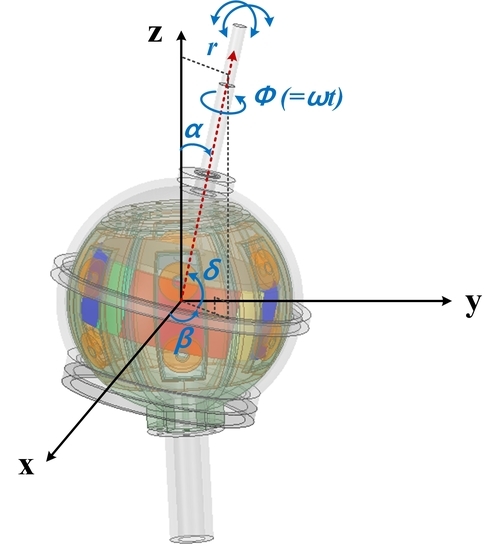Study on Multi-DOF Actuator for Improving Power Density
Abstract
1. Introduction
2. Theory of Dual-Airgap Slotless-Type Spherical Multi-DOF Actuator
2.1. Operation of the Spherical Multi-DOF Actuator
2.2. Spherical Multi-DOF Actuator Using Halbach Magnet Array Structure
3. Power Density Improvement
3.1. Output Characteristics Based on Magnet Array Structure
3.2. Detailed Design of Spherical Multi-DOF Actuator Using Halbach Magnet Array
3.3. Stability Characteristics
3.4. Control Method
4. Conclusions
Author Contributions
Funding
Conflicts of Interest
References
- Palpacelli, M.-C.; Carbonari, L.; Palmieri, G.; Callegari, M. Analysis and design of a reconfigurable 3-DoF parallel manipulator for multimodal tasks. IEEE/ASME Trans. Mechatron. 2014, 20, 1975–1985. [Google Scholar] [CrossRef]
- Cho, S.; Lim, J.-S.; Oh, Y.J.; Jeong, G.; Kang, D.-W.; Lee, J. A Study on Output Characteristics of the Spherical Multi-DOF Motor According to the Number of Phases and Pole Pitch Angles. IEEE Trans. Magn. 2018, 54, 1–5. [Google Scholar] [CrossRef]
- Bhattacharyya, S.; Shimoda, S.; Hayashibe, M. A synergetic brain-machine interfacing paradigm for multi-DOF robot control. IEEE Trans. Syst. Manand Cybern. Syst. 2016, 46, 957–968. [Google Scholar] [CrossRef]
- Ueki, S.; Kawasaki, H.; Ito, S.; Nishimoto, Y.; Abe, M.; Aoki, T.; Ishigure, Y.; Ojika, T.; Mouri, T. Development of a hand-assist robot with multi-degrees-of-freedom for rehabilitation therapy. IEEE/ASME Trans. Mechatron. 2010, 17, 136–146. [Google Scholar] [CrossRef]
- Mori, S.; Tanaka, K.; Nishikawa, S.; Niiyama, R.; Kuniyoshi, Y. High-Speed and Lightweight Humanoid Robot Arm for a Skillful Badminton Robot. IEEE Robot. Autom. Lett. 2018, 3, 1727–1734. [Google Scholar] [CrossRef]
- Lee, H.-J.; Park, H.-J.; Hong, H.-S.; Won, S.-H.; Jin, C.-S.; Lee, B.-S.; Lee, J. An analytic analysis of the multi-degree-of-freedom actuator. IEEE Trans. Magn. 2015, 51, 1–4. [Google Scholar]
- Hong, H.-S.; Won, S.-H.; Lee, H.-W.; Bae, J.-N.; Lee, J. Design of Torque Actuator in Hybrid Multi-DOF System Considering Magnetic Saturation. IEEE Trans. Magn. 2015, 51, 1–4. [Google Scholar] [CrossRef]
- Dehez, B.; Galary, G.; Grenier, D.; Raucent, B. Development of a spherical induction motor with two degrees of freedom. IEEE Trans. Magn. 2006, 42, 2077–2089. [Google Scholar] [CrossRef]
- Yang, X.; Liu, Y.; Chen, W.; Liu, J. Sandwich-type multi-degree-of-freedom ultrasonic motor with hybrid excitation. IEEE Access 2016, 4, 905–913. [Google Scholar] [CrossRef]
- Xia, C.; Xin, J.; Li, H.; Shi, T. Design and analysis of a variable arc permanent magnet array for spherical motor. IEEE Trans. Magn. 2012, 49, 1470–1478. [Google Scholar] [CrossRef]
- Li, Z.; Lun, Q.; Xing, D.; Gao, P. Analysis and implementation of a 3-DOF deflection-type PM motor. IEEE Trans. Magn. 2015, 51, 1–4. [Google Scholar] [CrossRef]
- Rossini, L.; Mingard, S.; Boletis, A.; Forzani, E.; Onillon, E.; Perriard, Y. Rotor design optimization for a reaction sphere actuator. IEEE Trans. Ind. Appl. 2013, 50, 1706–1716. [Google Scholar] [CrossRef]
- Lee, K.-M.; Son, H. Distributed multipole model for design of permanent-magnet-based actuators. IEEE Trans. Magn. 2007, 43, 3904–3913. [Google Scholar] [CrossRef]
- Takahara, K.; Hirata, K.; Niguchi, N.; Nishiura, Y.; Sakaidani, Y. Experimental evaluation of the static characteristics of multi-degree-of-freedom spherical actuators. IEEE Trans. Magn. 2017, 53, 1–5. [Google Scholar]
- Tsukano, M.; Sakaidani, Y.; Hirata, K.; Niguchi, N.; Maeda, S.; Zaini, A. Analysis of 2-degree of freedom outer rotor spherical actuator employing 3-D finite element method. IEEE Trans. Magn. 2013, 49, 2233–2236. [Google Scholar] [CrossRef]
- Sugimoto, H.; Kamiya, K.; Nakamura, R.; Asama, J.; Chiba, A.; Fukao, T. Design and basic characteristics of multi-consequent-pole bearingless motor with bi-tooth main poles. IEEE Trans. Magn. 2009, 45, 2791–2794. [Google Scholar] [CrossRef]
- Bai, K.; Lee, K.-M. Direct field-feedback control of a ball-joint-like permanent-magnet spherical motor. IEEE/ASME Trans. Mechatron. 2013, 19, 975–986. [Google Scholar] [CrossRef]
- Maeda, S.; Hirata, K.; Niguchi, N. Dynamic analysis of an independently controllable electromagnetic spherical actuator. IEEE Trans. Magn. 2013, 49, 2263–2266. [Google Scholar] [CrossRef]
- Son, H.; Lee, K.-M. Open-loop controller design and dynamic characteristics of a spherical wheel motor. IEEE Trans. Ind. Electron. 2010, 57, 3475–3482. [Google Scholar] [CrossRef]
- Aoyagi, M.; Beeby, S.P.; White, N.M. A novel multi-degree-of-freedom thick-film ultrasonic motor. IEEE Trans. Ultrason. Ferroelectr. Freq. Control 2002, 49, 151–158. [Google Scholar] [CrossRef]
- Takemura, K.; Ohno, Y.; Maeno, T. Design of a plate type multi-DOF ultrasonic motor and its self-oscillation driving circuit. IEEE/ASME Trans. Mechatron. 2004, 9, 474–480. [Google Scholar] [CrossRef]
- Kawano, H.; Ando, H.; Hirahara, T.; Yun, C.; Ueha, S. Application of a multi-DOF ultrasonic servomotor in an auditory tele-existence robot. IEEE Trans. Robot. 2005, 21, 790–800. [Google Scholar] [CrossRef]
- Li, H.; Xia, C.; Shi, T. Spherical harmonic analysis of a novel Halbach array PM spherical motor. In Proceedings of the 2007 IEEE International Conference on Robotics and Biomimetics, Sanya, China, 15–18 December 2007; pp. 2085–2089. [Google Scholar]
- Li, H.F.; Xia, C.L.; Song, P. Magnetic field analysis of a Halbach array PM spherical motor. In Proceedings of the 2007 IEEE International Conference on Automation and Logistics, Jinan, China, 18–21 August 2007; pp. 2019–2023. [Google Scholar]
- Oh, Y.-J.; Lee, W.-K.; Lee, H.-J.; Kang, D.-W.; Won, S.-H.; Lee, J. Position Estimation for the Permanent Magnet Spherical Motor using Optical Image Sensor. In Korean Institute of Electrical Engineers Summer Conference; The Korean Institute of Electrical Engineers: Seoul, Korea, 2011; pp. 943–944. [Google Scholar]
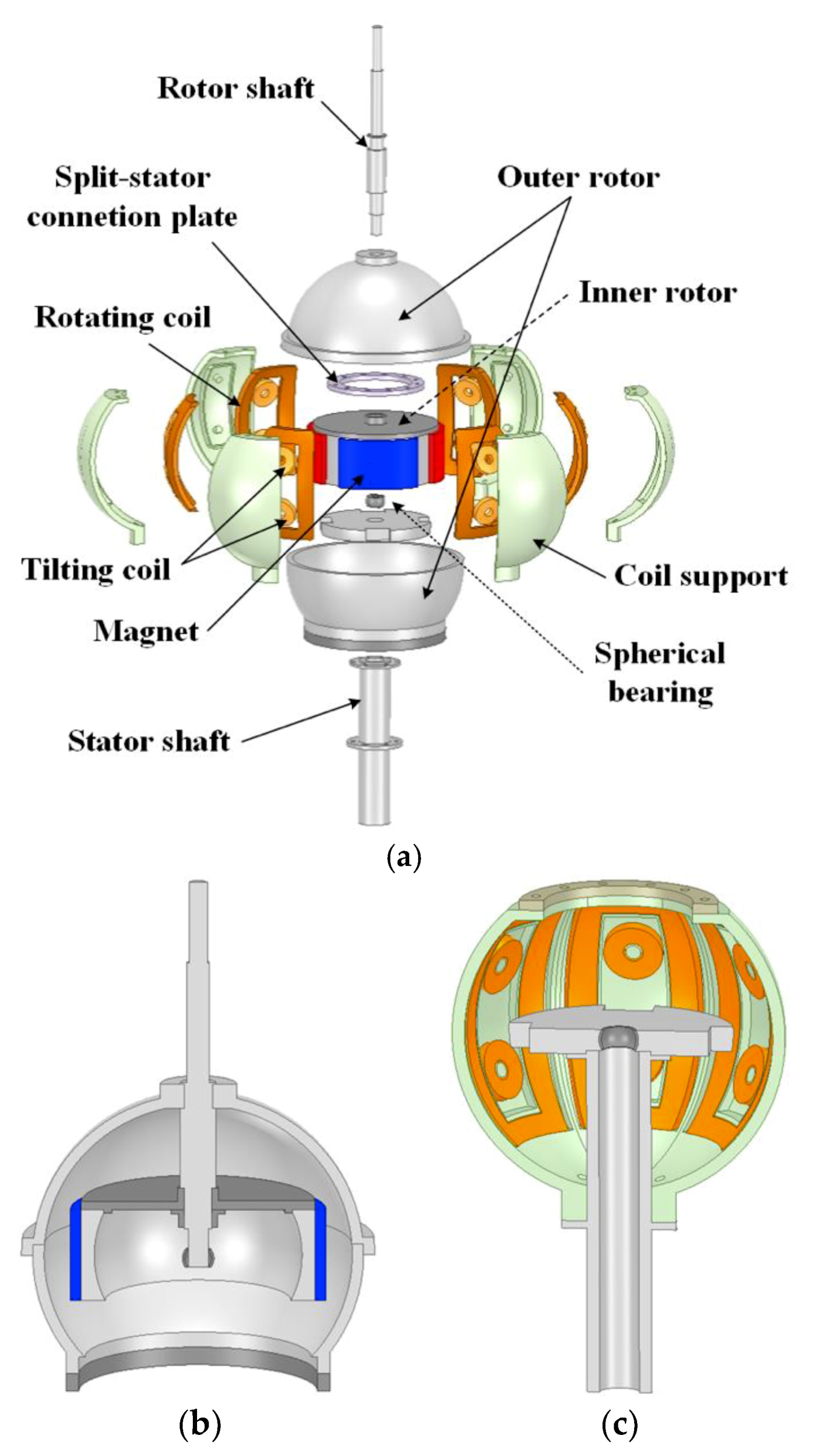


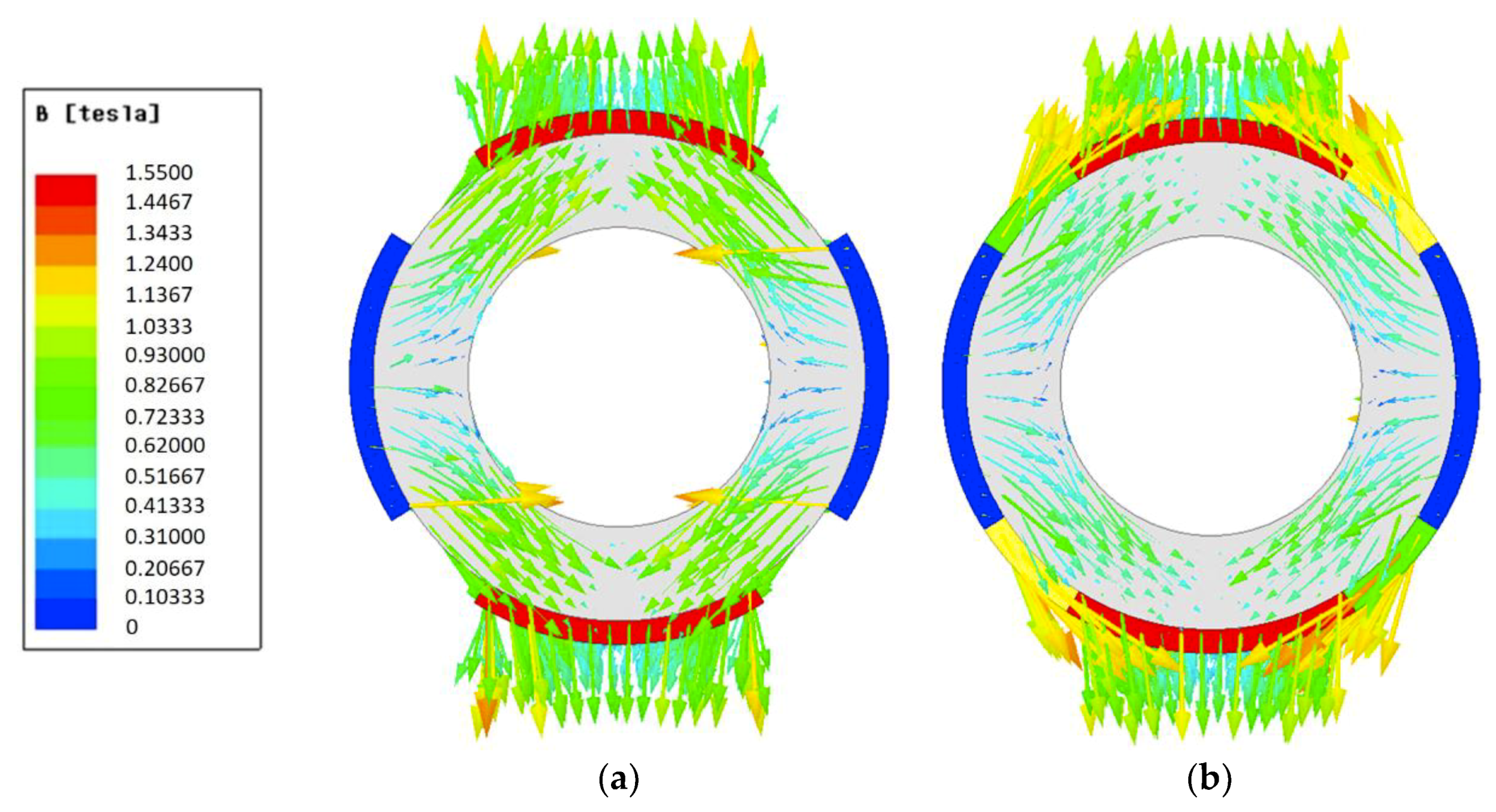
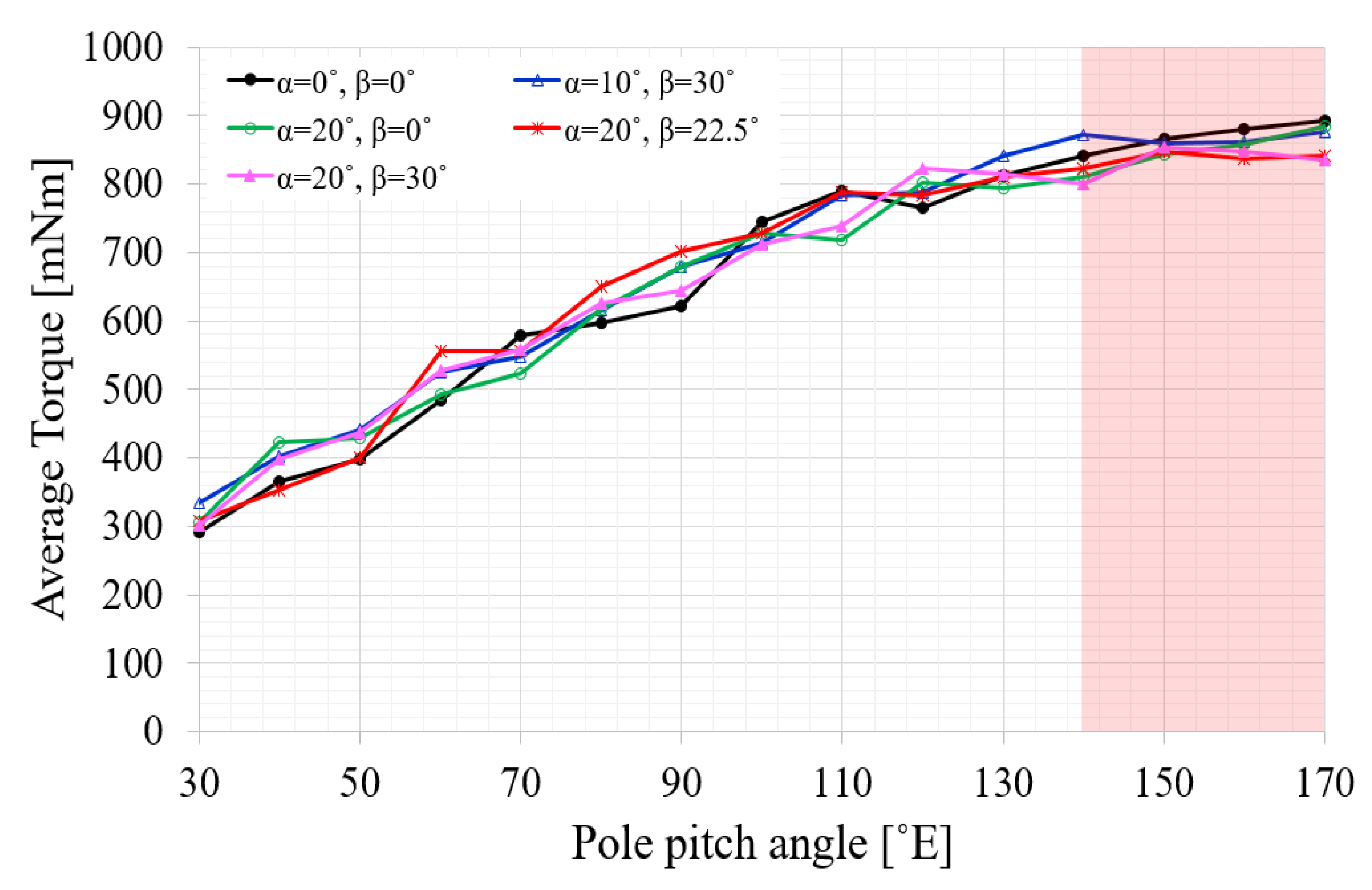
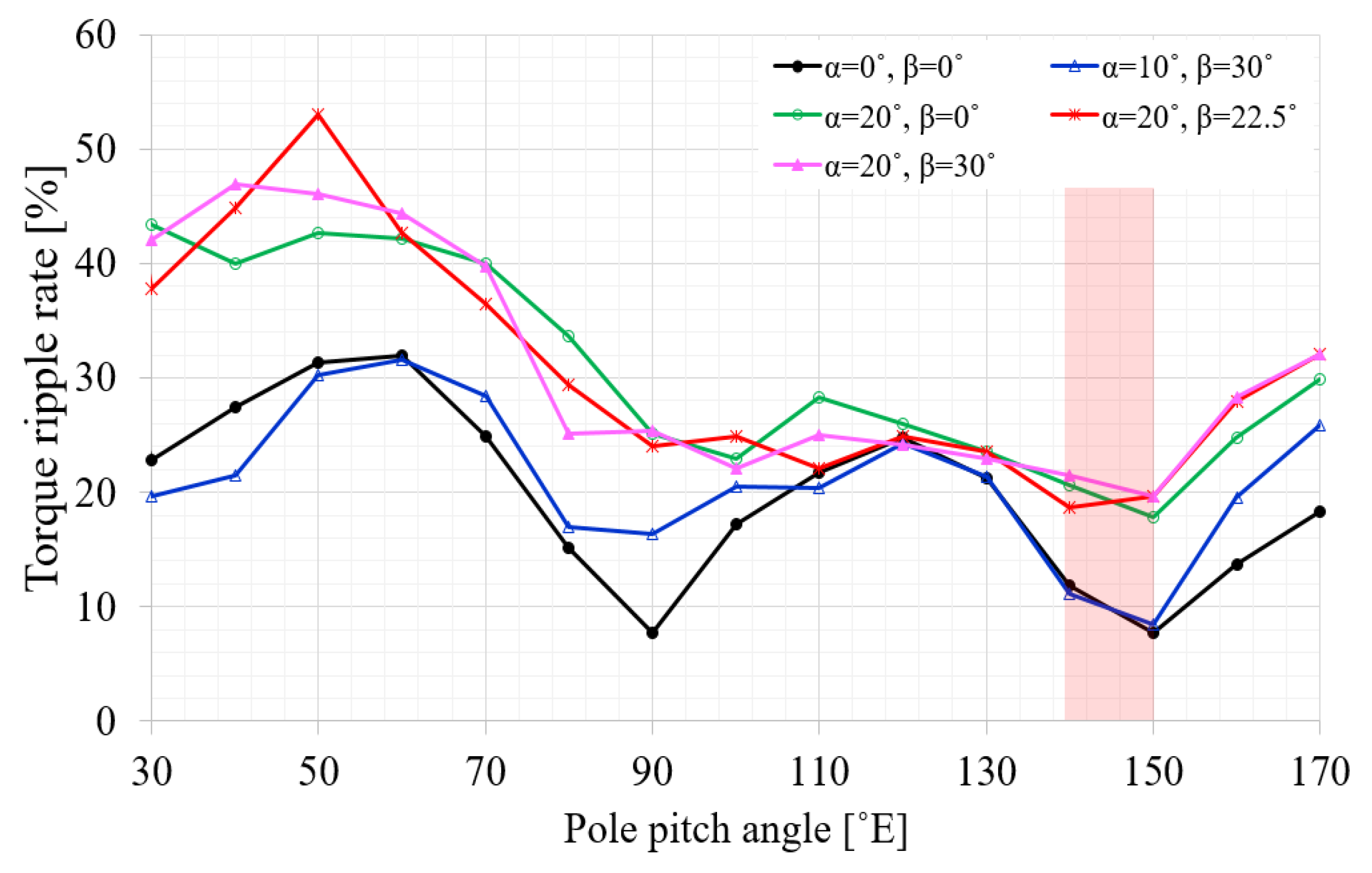
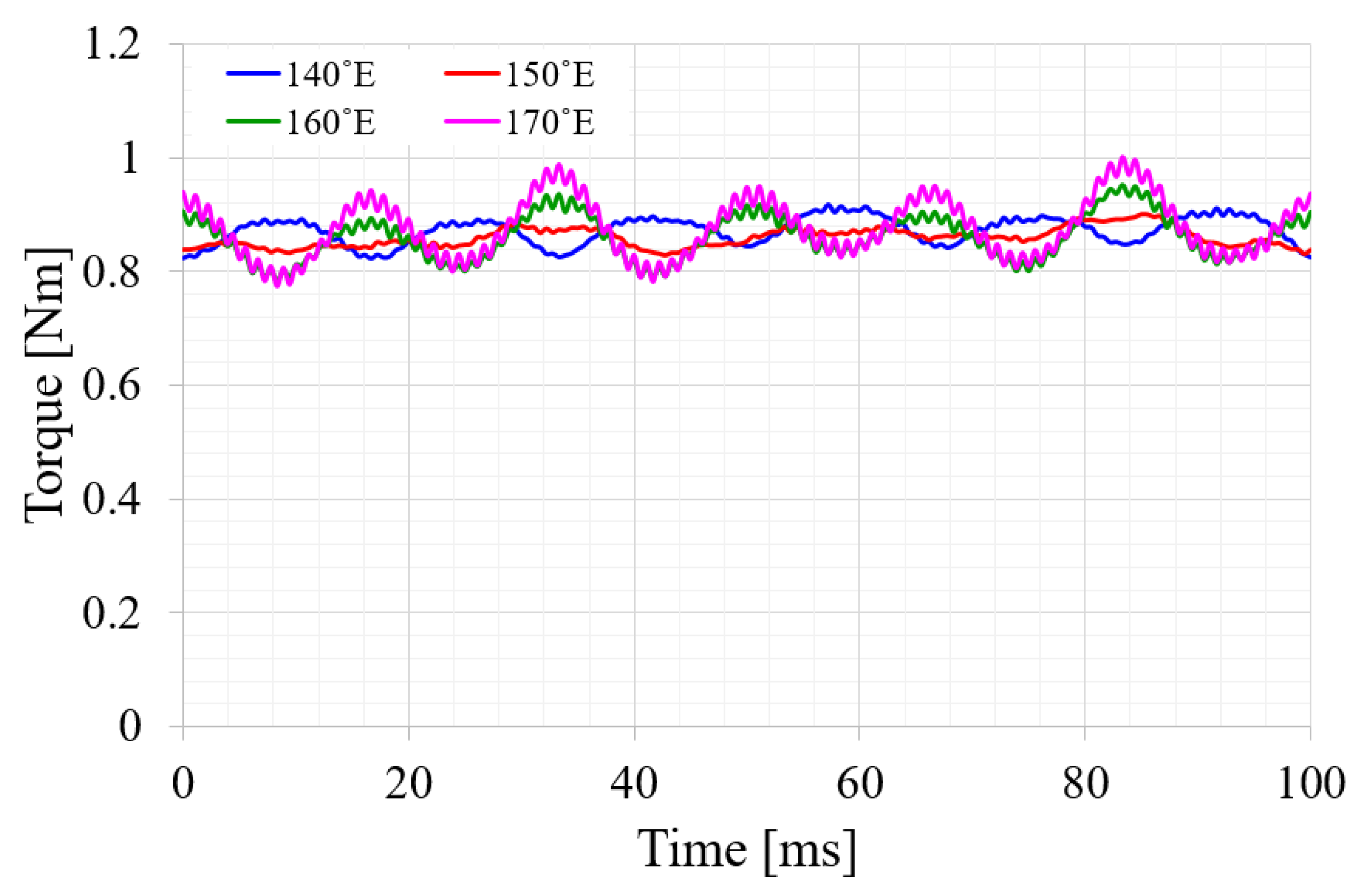
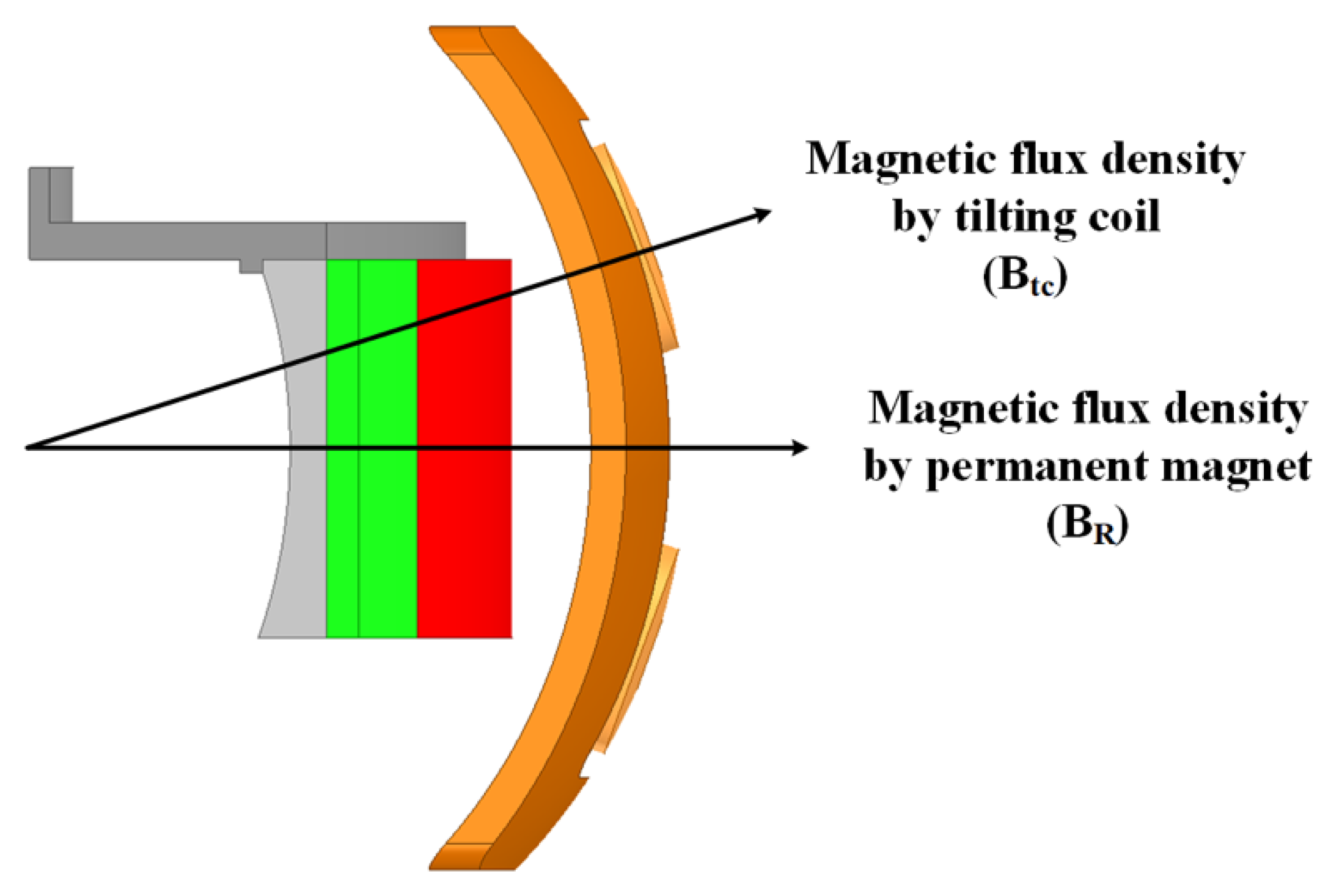
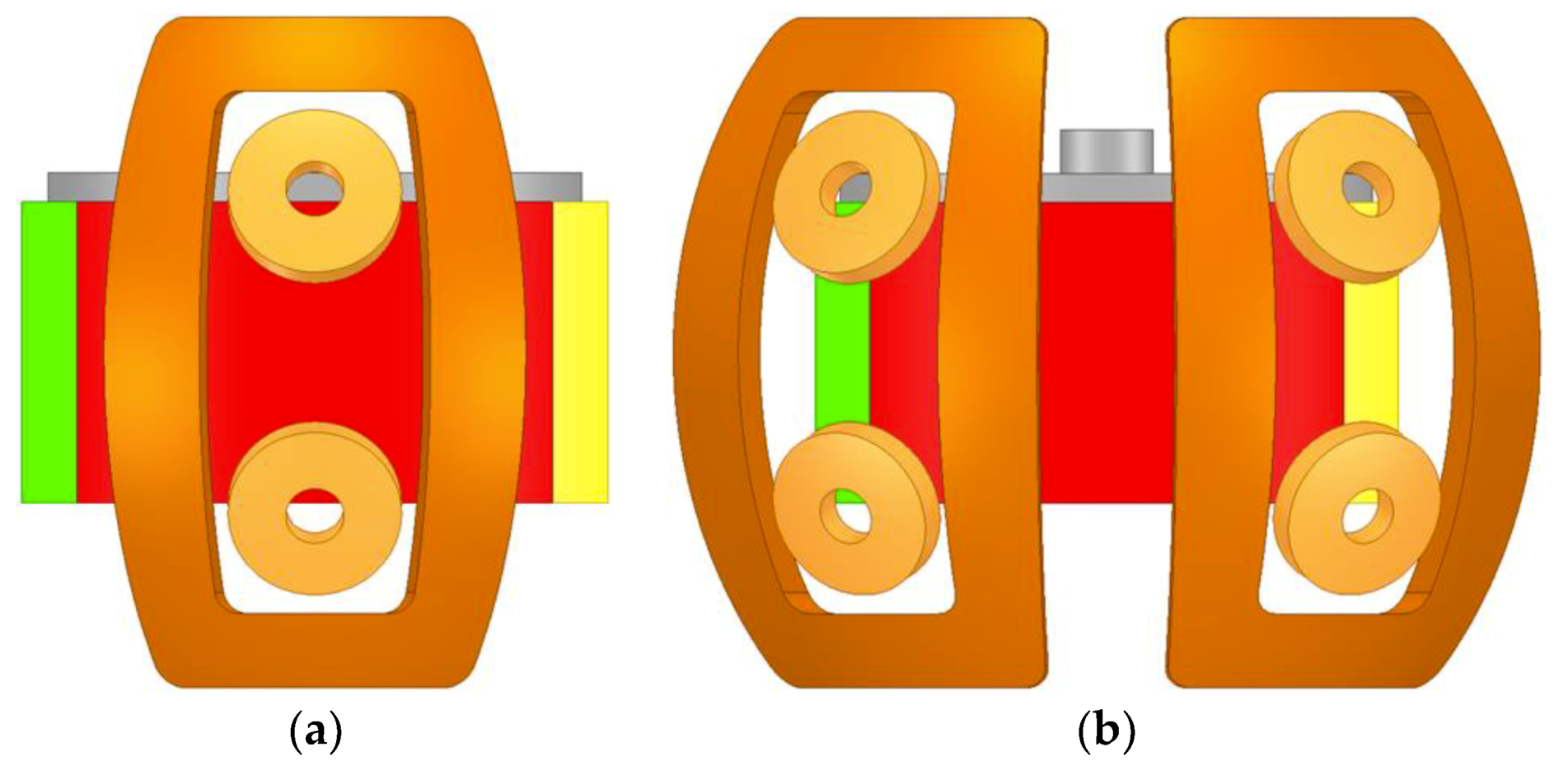
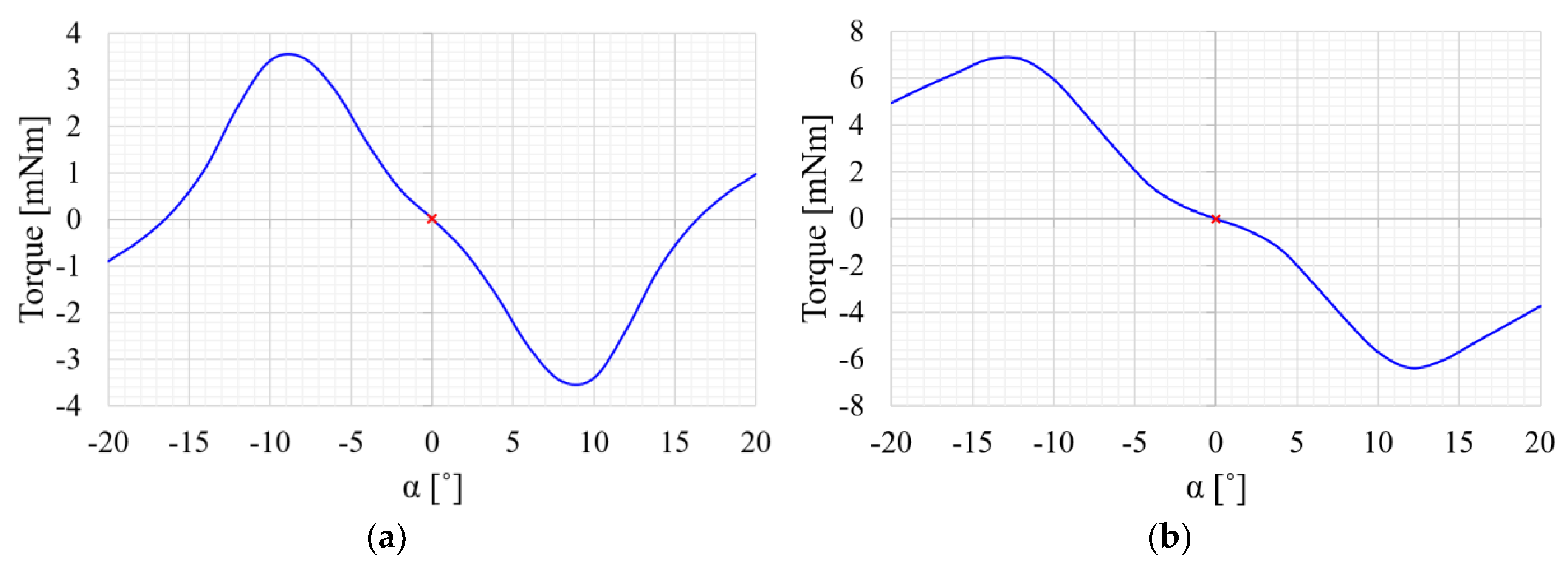
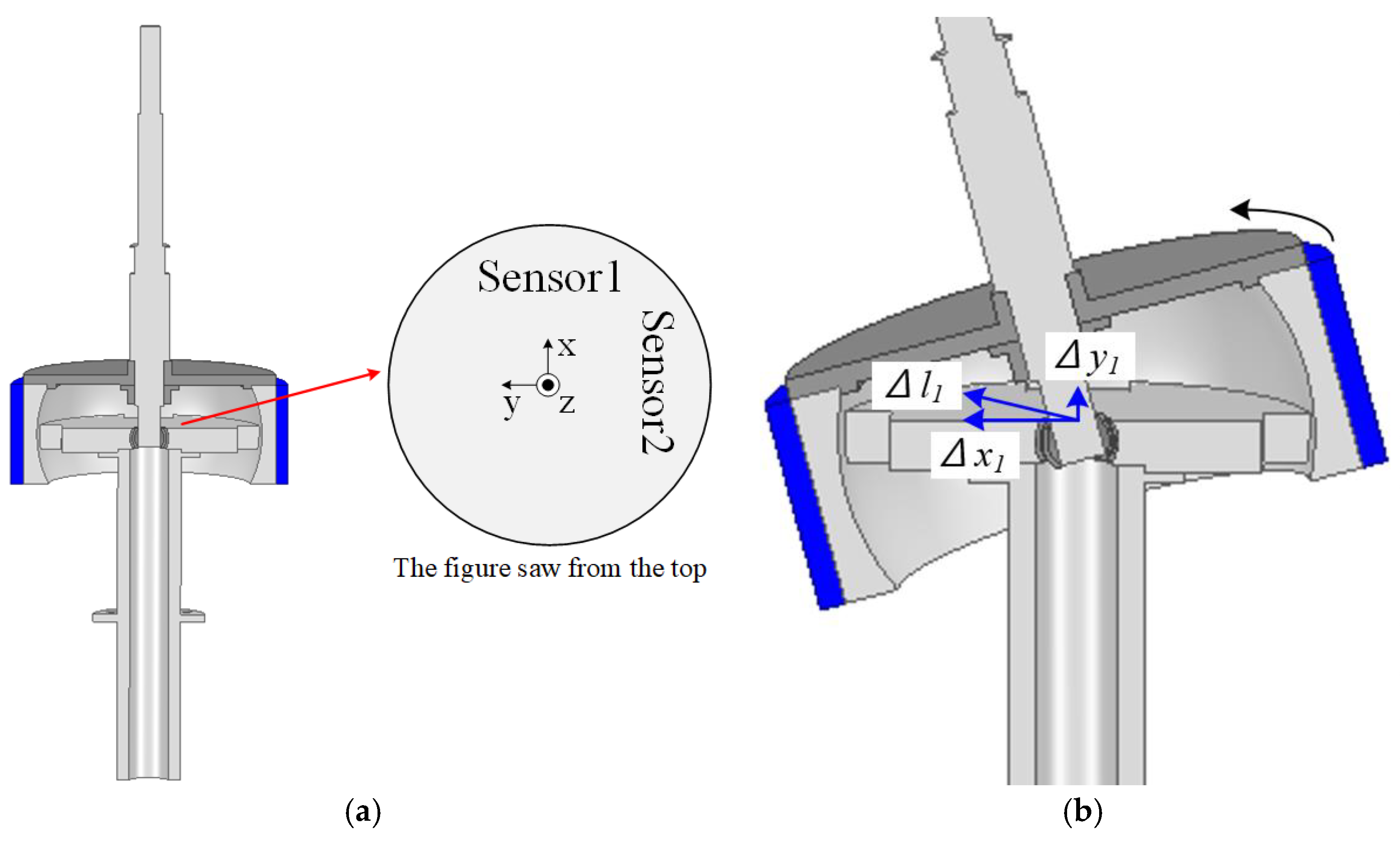
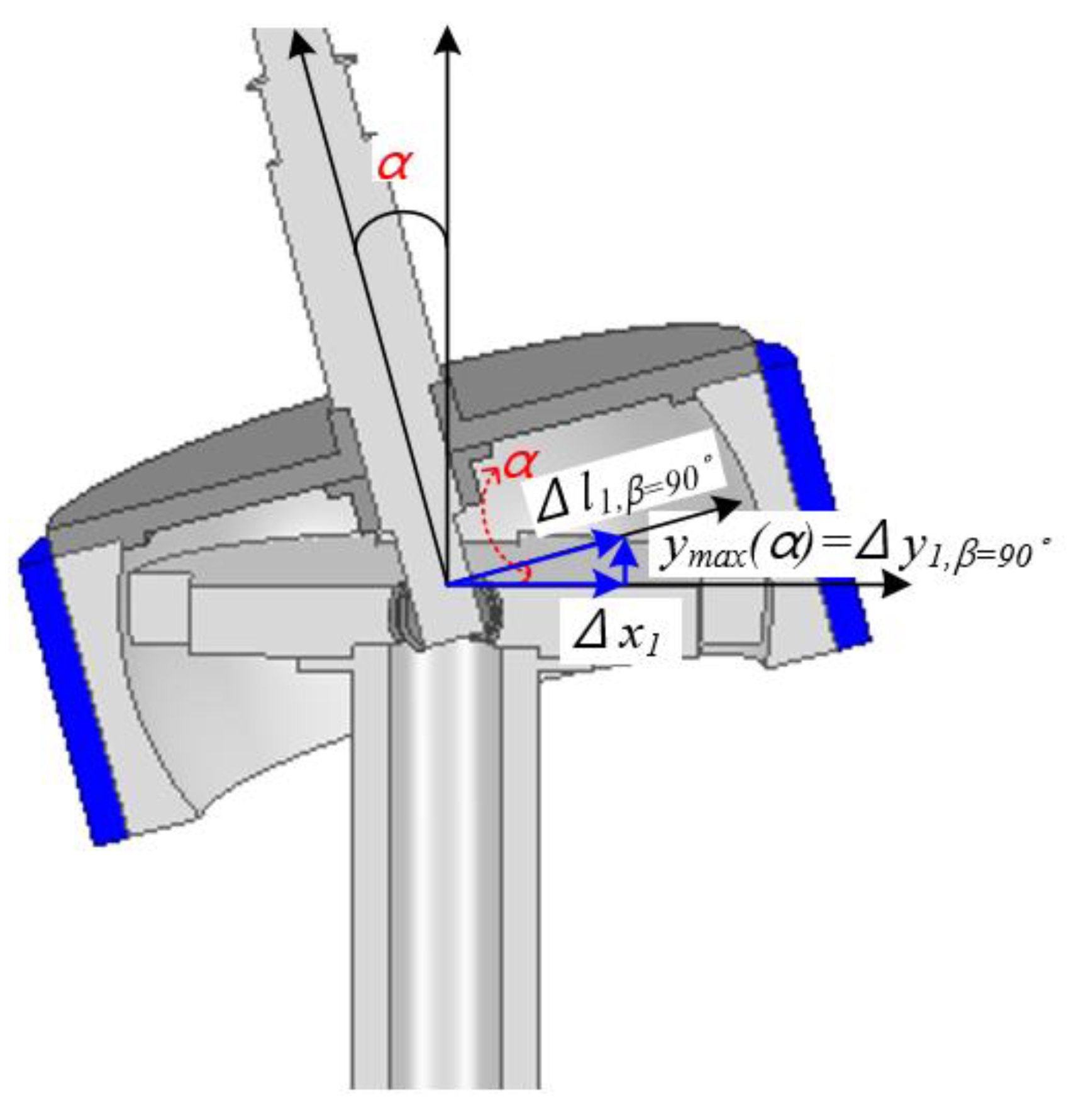
| Contents | Value | Unit |
|---|---|---|
| Number of phases | 3 | − |
| Number of poles | 4 | − |
| Number of rotating coils & tilting coils | 6/6 | − |
| Number of rotating turns & tilting turns | 170/250 | turns |
| Input current | 0.5 | Amax |
| Pole pitch angle | 130 | °E |
| Average rotating torque (α = 0°, β = 0°) | 410 | mNm |
| Power density (α = 0°, β = 0°) | 7744.3 | W/m3 |
| Efficiency at 300 rpm (α = 0°, β = 0°) | 77.97 | % |
| Contents | Basic Model | Halbach Magnet Array Model | Unit |
|---|---|---|---|
| Air-gap magnetic flux density (Bg1) | 0.39 | 0.41 | T |
| Contents | Basic Model | Halbach Magnet Array Model | Unit |
|---|---|---|---|
| Speed | 300 | rpm | |
| Pole pitch angle | 130 | °E | |
| Average torque | 482.4 | 523.3 | mNm |
| Torque ripple rate | 24.4 | 10.2 | % |
| Power | 15.2 | 16.4 | W |
| Power density | 8749.8 | 9119.5 | W/m3 |
| Efficiency | 80.7 | 81.9 | % |
| Contents | Halbach Magnet Array Model | New Halbach Magnet Array Model | Unit |
|---|---|---|---|
| Speed | 300 | rpm | |
| Pole pitch angle | 130 | °E | |
| Number of rotating turns | 170 | 370 | turns |
| Average torque | 523.3 | 811.9 | mNm |
| Power | 16.4 | 25.5 | W |
| Power density | 9119.5 | 13,601.3 | W/m3 |
| Contents | Value | Unit |
|---|---|---|
| Diameter of the outer rotor | 147 | mm |
| Diameter of the inner rotor | 113.7 | mm |
| Thickness of the outer rotor | 137 | mm |
| Thickness of the inner part’s airgap (min/max) | 1.5/5.15 | mm |
| Thickness of the outer part’s airgap | 1.5 | mm |
| Thickness of the magnet | 5 | mm |
| Pole pitch angle | 150 | °E |
| Residual magnetic flux density of the magnet | 1.25 | T |
| Total mass | 4.99 | kg |
© 2019 by the authors. Licensee MDPI, Basel, Switzerland. This article is an open access article distributed under the terms and conditions of the Creative Commons Attribution (CC BY) license (http://creativecommons.org/licenses/by/4.0/).
Share and Cite
Cho, S.; Lee, H.J.; Lee, J. Study on Multi-DOF Actuator for Improving Power Density. Energies 2019, 12, 4204. https://doi.org/10.3390/en12214204
Cho S, Lee HJ, Lee J. Study on Multi-DOF Actuator for Improving Power Density. Energies. 2019; 12(21):4204. https://doi.org/10.3390/en12214204
Chicago/Turabian StyleCho, Sooyoung, Ho Joon Lee, and Ju Lee. 2019. "Study on Multi-DOF Actuator for Improving Power Density" Energies 12, no. 21: 4204. https://doi.org/10.3390/en12214204
APA StyleCho, S., Lee, H. J., & Lee, J. (2019). Study on Multi-DOF Actuator for Improving Power Density. Energies, 12(21), 4204. https://doi.org/10.3390/en12214204




